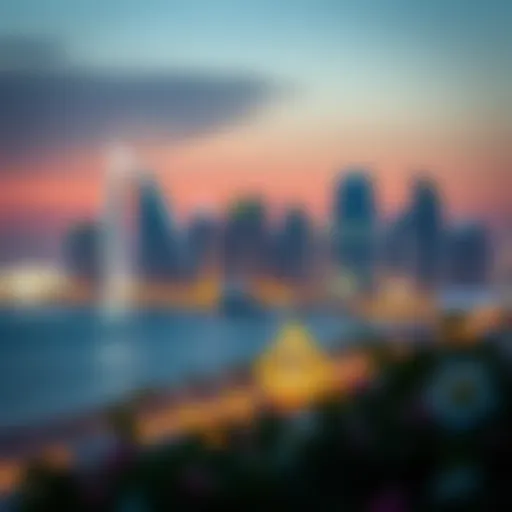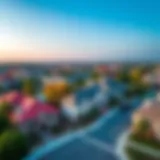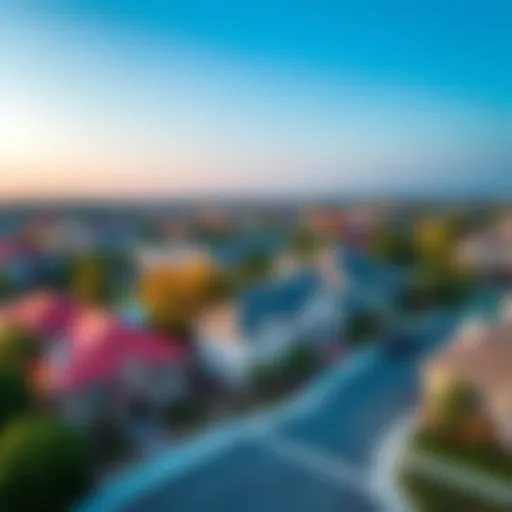Discovering Al Fahidi Heritage Village: Dubai's Cultural History
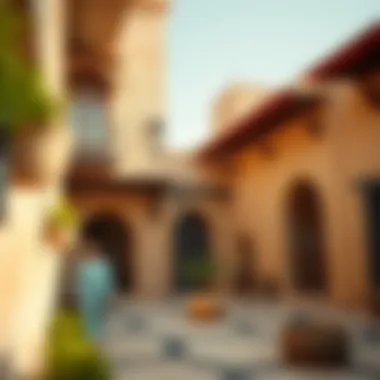
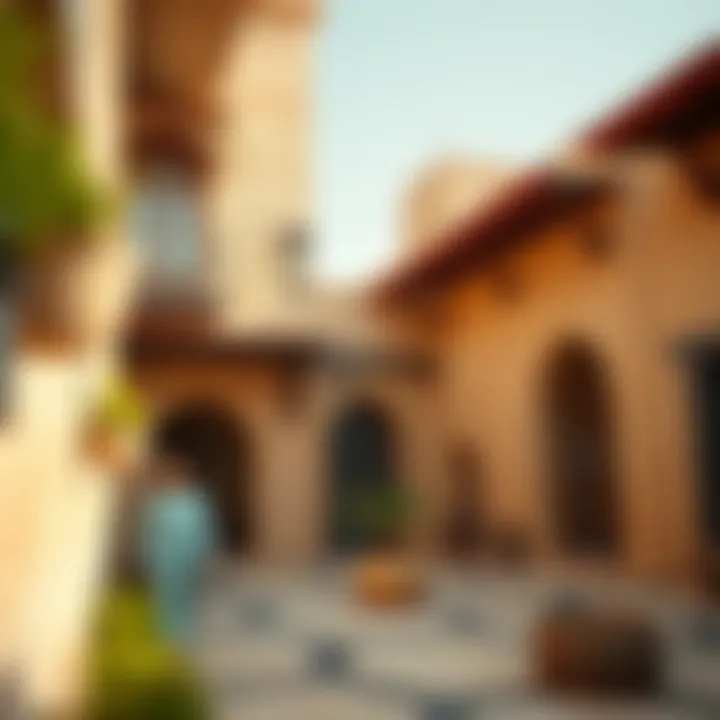
Intro
Nestled within the bustling metropolis of Dubai lies a gem that offers a slice of the Emirates’ past: Al Fahidi Heritage Village. This cultural landmark is more than just a series of buildings; it represents a microcosm of the UAE's rich traditions, ways of life, and architectural heritage. Stepping into the village is akin to walking through a time machine, where the rapid modernization of the city dissolves away, revealing glimpses of simpler times. As one traverses these narrow lanes lined with wind towers and mud-brick walls, it becomes evident that Al Fahidi serves as a vital source of knowledge about the Emirates' history.
As we explore this vibrant historical site, we will delve into its architectural styles, community activities, and the cultural motifs that breathe life into its structures. This examination aims to not only highlight the village's immediate significance but also bring to light its crucial role in ongoing heritage conservation efforts.
The significance of Al Fahidi cannot be overstated, especially in a rapidly evolving urban landscape. It is a repository of stories from the past, a place where history is preserved against the backdrop of an ever-changing future. With each corner of Al Fahidi, one can learn about the traditional Emirati lifestyle before the influx of modernization that characterized the 20th century. By dissecting these elements, the narrative of Al Fahidi expands to encompass broader themes of cultural identity and the importance of preserving such sites for future generations.
Prelims to Al Fahidi Heritage Village
Al Fahidi Heritage Village, often dubbed as the cultural heartbeat of Dubai, offers a tangible glimpse into the original echo of Emirati life before the winds of modernization changed the landscape. It serves as more than just a historical landmark; it functions as a living museum where the traditions, architecture, and community of the past find a stage in the bustling narrative of contemporary Dubai. By exploring this unique village, one not only marvels at the resilience of traditional practices but also engages in a dialogue about the relationship between history and modernity.
In this article, we delve into the components that make Al Fahidi significant. From its layout reflecting the social fabric of its time to the nuanced architecture that tells stories of craftsmanship and ingenuity, Al Fahidi Heritage Village is a treasure trove of information. Moreover, the village plays a fundamental role in preserving the cultural identity of the UAE amidst a rapid urban expansion.
This careful exploration serves multiple purposes:
- Awareness of Cultural Heritage: Understanding Al Fahidi allows visitors and residents to appreciate the depth of Emirati history, shaping a communal identity that transcends generations.
- Dialogue on Urban Development: The village stands as a case study of how heritage can be both safeguarded and showcased even in a modern context.
- Community Engagement: Al Fahidi involves local artisans and craftspeople, thereby fostering intergenerational knowledge transfer and community ties.
In presenting these layers of Al Fahidi, we engage with something much larger—an exploration of a society grappling with its past even as it strides confidently into the future.
Location and Accessibility
Al Fahidi Heritage Village nestles in the vibrant district of Bur Dubai, providing easy access from various points in the city. Located near the banks of the Dubai Creek, it’s surrounded by a mix of modern skyscrapers and ancient alleyways, aptly showcasing the juxtaposition of old and new. This geographical positioning makes it a linking point for tourists and locals alike, facilitating visits from nearby destinations, such as the Dubai Museum and the historic Bastakiya Quarter. Visitors can easily reach Al Fahidi via the Dubai Metro, with a short walk from the Al Fahidi station, or through traditional abra boats that traverse the creek.
Public Transport Options:
- Dubai Metro: Al Fahidi station (green line) is a stone’s throw away.
- Buses: Numerous Dubai bus routes pass nearby, making it convenient.
- Water Transport: Abra boats offer a scenic route across the creek, giving a picturesque start to the heritage experience.
Accessibility extends beyond mere physical location. The village is equipped with amenities to welcome diverse groups including families, international tourists, and locals. Thoughtful provisions such as ample resting areas and informational signage in multiple languages ensure that visitors can fully dive into the rich offerings of Al Fahidi.
Historical Context
To truly grasp the essence of Al Fahidi Heritage Village, one must consider its historical backdrop. Established in the late 19th century, it reflects the socio-economic dynamics that once shaped Dubai. Initially, it functioned as a commercial trading hub wherein merchants from Persia and India exchanged not only goods but knowledge and customs. The layout of Al Fahidi was strategically designed, with narrow alleyways and tall wind towers—known as barjeels—allowing for natural ventilation, essential in the hot Arabian climate.
The village showcases buildings made from traditional materials like coral stone and palm fronds. These structures bear witness to the architectural ingenuity of the time, crafted not merely for aesthetics but for function and climate adaptation. The very walls tell tales of a community grounded in trade, where each villager contributed to a tapestry of shared existence.
As such, Al Fahidi stands as a symbol of resilience against the backdrop of change, embodying the spirit of the Emirati people who have continually woven their identity amidst transformation. The village was largely preserved alongside Dubai's rapid growth in the late 20th century, signifying an acknowledgment of heritage that challenges the narrative of relentless modernization.
This historical framework allows a deeper understanding of not only the village but also the wider cultural significance it holds in contemporary Dubai. By reflecting on Al Fahidi’s past, visitors gain insights into the values and traditions that continue to shape the UAE today.
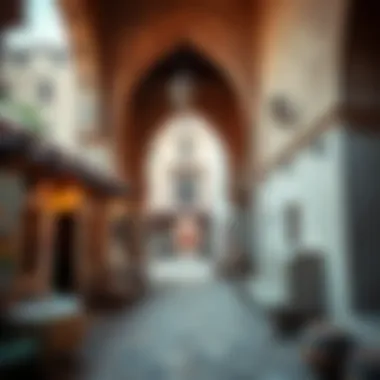
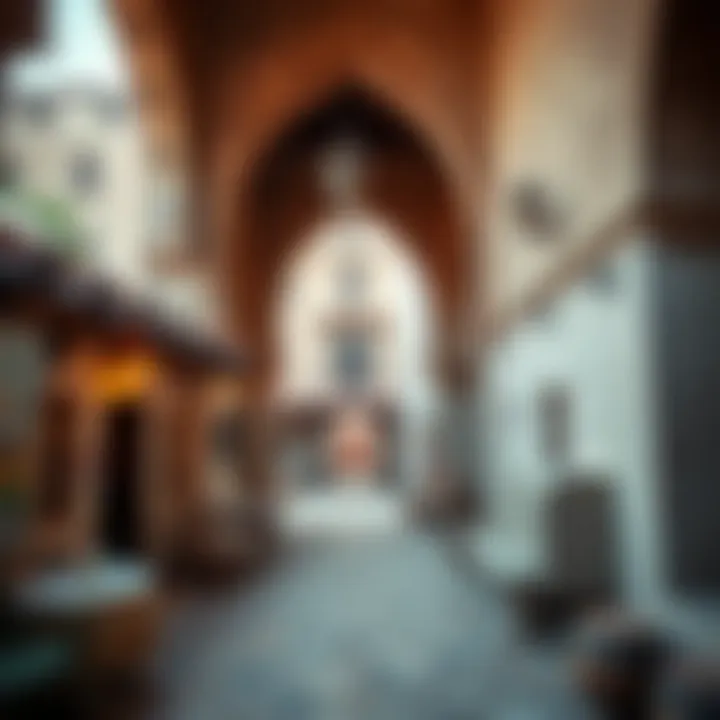
Architectural Features
When exploring Al Fahidi Heritage Village, it becomes clear that the architectural features are not just pleasing to the eye; they tell stories woven with threads of history, culture, and survival. These structures give insight into how inhabitants thrived in the arid climate and how they balanced aesthetics with functionality. Understanding these features is key to appreciating the rich cultural tapestry that defines Dubai today.
Traditional Building Materials
The buildings in Al Fahidi Heritage Village were predominantly constructed using materials sourced locally. This included clay, stone, and palm fronds, providing not only a sense of place but also showcasing the resourcefulness of the Emirati people.
For instance, mud brick was widely employed for its thermal mass, keeping interiors cool during the scorching summer months. Roofs made of palm fronds demonstrated sustainable practices; they were abundant, easily accessible, and offered excellent insulation. The choice of such materials reflects a deep understanding of the local environment and a harmonious relationship with nature.
Cultural Significance
Cultural significance of Al Fahidi Heritage Village extends far beyond its picturesque streets and traditional architecture. It serves as a symbol of a thriving community rooted in rich historical traditions while navigating the swift currents of modernity. This village is not merely a place to visit; it represents a living legacy, preserving the essence of Emirati culture and embodying the vibrancy of its heritage.
Preserving Heritage and Identity
In the heart of Dubai, Al Fahidi Heritage Village stands as a testament to the enduring spirit of the Emirati people. Its rows of wind-tower buildings and traditional souks offer us more than just an architectural delight; they safeguard the cultural identity of a society that has seen tremendous change. Here, visitors can explore exhibits featuring bedouin life, traditional garments, and historical artifacts that narrate the stories of generations past.
- Community Participation: This site encourages involvement from local heritage organizations and artisans. Their contributions ensure that traditions are not forgotten, for they teach visitors about the crafts passed down through the ages.
- Authentic Experiences: Within the village, folk dances and music echo the sentiments of a bygone era, inviting people to partake in cultural events. These immersive experiences immerse visitors in the narratives that define Emirati identity.
Furthermore, regular festivals and exhibitions foster pride among locals. Such gatherings act as cornerstones for communal bonds, enriching the social framework of the Emirati people.
Role in Cultural Education
Al Fahidi Heritage Village plays a crucial role in cultural education, acting as a bridge between the past and the present. Here, teachers of all ages can discover Emirati culture firsthand, helping them understand its intricacies and values.
"Knowledge is not just power—it's a platform for understanding, bridging gaps, and promoting cultural diversity."
Workshops and guided tours serve as educational tools that not only showcase traditional craft techniques but also provoke thought on the importance of cultural preservation. Visitors can engage in pottery-making or weaving activities, experiencing firsthand the labor involved in these ancient arts.
Some teaching institutions even partner with the village to integrate local history into their curriculums. Through school trips and community outreach, students gain insight into the emirate’s foundations, preparing them to appreciate their cultural inheritance. Thus, Al Fahidi Heritage Village stands out not just as a historical site, but as a beacon of educational enlightenment—a true hub for cultivating an enduring appreciation of the nation's heritage.
In summary, Al Fahidi Heritage Village is more than a collection of old buildings; it’s a cultural mosaic that reflects Dubai's narrative, instilling identity and fostering future generations. Each visit is an invitation to explore and understand the intricate tapestry of life's experiences woven together over centuries.
For more on Dubai's cultural heritage, you may visit Britannica, or explore community discussions on platforms like Reddit.
Community Engagement
Community engagement serves as the lifeblood of Al Fahidi Heritage Village, intertwining the village's historical significance with modern-day relevance. This engagement manifests through the efforts of local artisans, craftspeople, and various cultural programs that resonate with both residents and visitors. The importance of fostering these connections cannot be overstated; they not only celebrate Emirati culture but also ensure the preservation of traditions that could otherwise fade in the whirl of modern life.
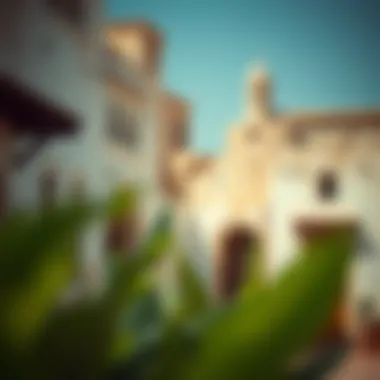
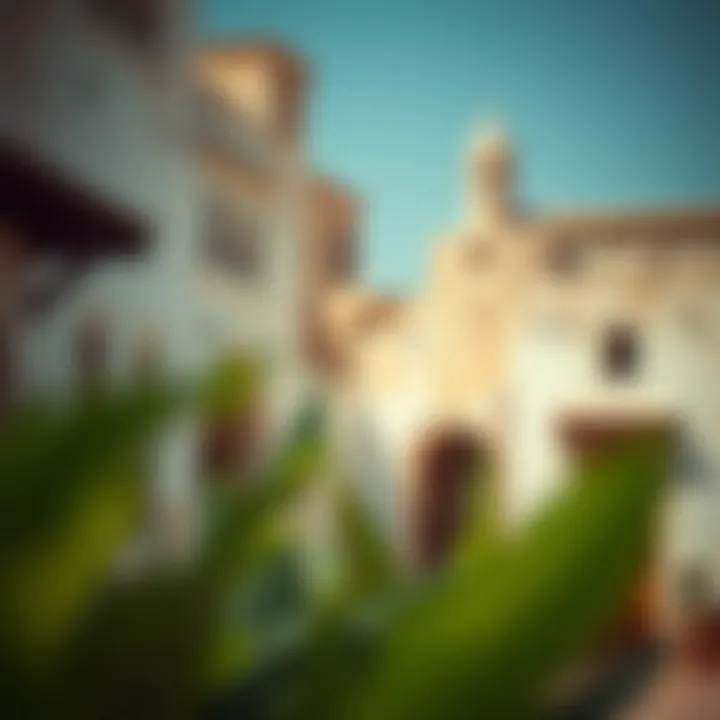
Local Artisans and Craftspeople
One of the striking features of Al Fahidi Heritage Village is the enthusiastic participation of local artisans and craftspeople, each contributing to the cultural tapestry of the area. Artisans skilled in traditional crafts like pottery, weaving, and calligraphy carry the weight of their ancestors’ skills into the present. When you wander the village, it is common to see these craftspeople demonstrating their techniques, engaging passersby in their art.
- Skills Passed Down: Many artisans highlight how they learned their crafts from family members, preserving these art forms through generations. This passing of knowledge fosters a sense of identity not only for the artisans but for the broader community as well.
- Economic Benefits: Supporting these local artisans also empowers them economically. Visitors who purchase handmade goods directly from the makers help sustain their livelihoods, reinforcing a circular economy within the community.
- Collaboration: The artisans often collaborate on projects, creating workshops where participants can learn a craft from a master. This collaboration builds a sense of community while preserving Emirati traditions.
Contemporary art also finds its place in Al Fahidi, blending with traditional styles. Artists might experiment with new materials or digital mediums while staying rooted in local culture, thus reaching a broader audience.
Workshops and Cultural Programs
The village is not just a space for viewing history; it actively becomes a classroom through workshops and cultural programs that invite participation and learning. These events play a critical role in linking visitors with the cultural heritage of Dubai.
- Types of Workshops: Attendees can immerse themselves in various workshops, ranging from Arabic calligraphy classes to culinary sessions featuring traditional Emirati dishes. By participating, visitors not only learn skills but also engage in meaningful interactions with members of the community.
- Cultural Programs: Events such as storytelling nights and traditional dance performances augment the educational aspect of the village. Such programs often highlight important historical narratives and myths that shape Emirati identity.
- Engaging the Youth: Special programs are tailored for school groups and families, aiming to instill the values of cultural appreciation from a young age. The hope is that newer generations will carry forward the torch of tradition.
"Engagement is not merely about participation; it’s about forming bonds through shared experiences that honor our heritage."
In sum, community engagement within Al Fahidi Heritage Village plays a decisive role in breathing life into the past. By supporting local artisans and participating in cultural programs, both residents and visitors contribute to the ongoing narrative of Emirati culture. This preservation and promotion create a vibrant atmosphere where history and modernity coexist, shaping the future of Dubai's cultural landscape.
Tourism and Visitor Experience
Tourism plays a pivotal role in bringing life to Al Fahidi Heritage Village. It acts as a bridge, connecting local traditions with the outside world, allowing visitors to immerse themselves in the vibrant culture that defines Dubai's rich heritage. Every year, tourists flock to witness not only the traditional architecture but also to engage in activities that resonate with the Emirati way of life.
The experience of navigating through the narrow lanes of Al Fahidi is akin to stepping back in time. Each corner reveals an intricate story, whether it be about the artisans practicing their crafts or the ancient forms of trade that once flourished here. As visitors wander through the labyrinthine paths, they have the opportunity to indulge in the sensory delights: the scent of spices wafting through the air, the sound of soft whispers between locals sharpening their skills in unique crafts, and the playful laughter of children at nearby workshops.
Navigating the Village
To truly relish your visit to Al Fahidi Heritage Village, understanding how to get around is imperative. The village is designed to be explored on foot, which allows visitors to soak in the fine details that dot the landscape. Street signs in both Arabic and English ensure that language poses no barrier.
While exploring, one might take note of a few key landmarks, such as:
- The Sheikh Mohammed Centre for Cultural Understanding, where cultural tours are conducted.
- The Dubai Museum, housed in the Al Fahidi Fort, which portrays the city's history.
- Art galleries showcasing local and international talents.
Guides, often locals themselves, share the tales of yore, imparting deep knowledge that enriches the visitor experience. Keep an ear tuned for their stories—they bring the village alive with passion and clarity. Sometimes, it’s best to lose yourself in the winding paths rather than following strict itineraries.
Visitor Facilities and Amenities
The infrastructure within the village is modest yet effective, aligning well with its heritage-focused ethos. Key facilities cater to the needs and comfort of visitors, allowing them to enjoy their time without worry. Here are some of the amenities you can expect to find:
- Information Centers: Positioned at strategic points, offering maps and brochures that detail exhibitions and activities.
- Rest Areas: Equipped with seating and shaded areas, these spots provide a respite from the heat, encouraging visitors to relax and soak in the surroundings.
- Cafés and Shops: Visitors can indulge in traditional Emirati cuisine or shop for handcrafted souvenirs ranging from textiles to intricate pottery.
- Restroom Facilities: Clean and well-maintained, ensuring guests can refresh themselves before continuing their journey.
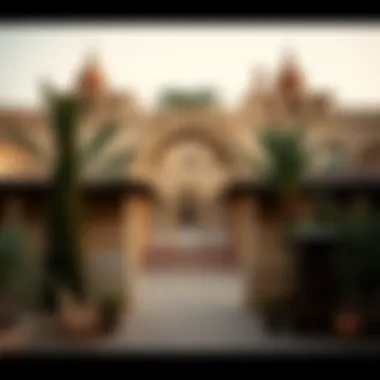
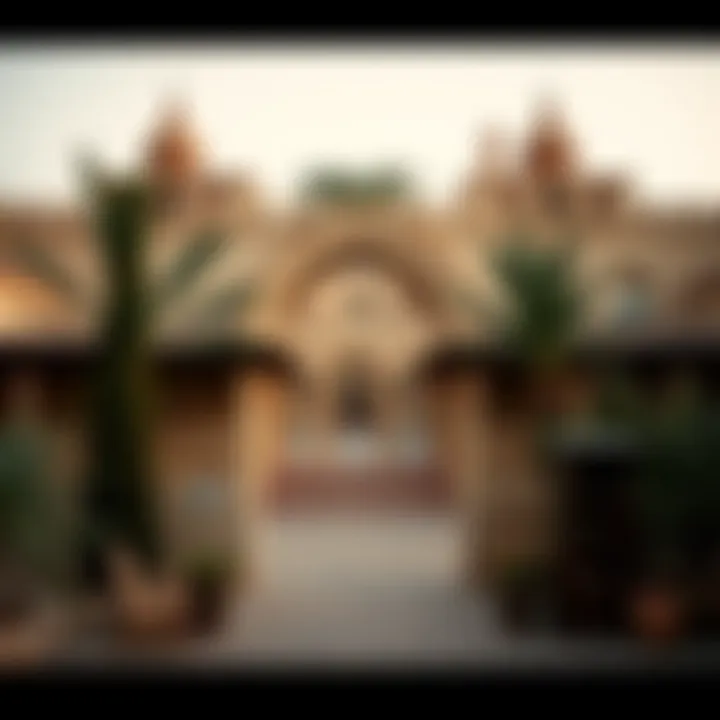
Visiting Al Fahidi Heritage Village is not just an exploration; it's a way to reconnect with the roots of culture amid the fast-paced change of modern Dubai.
In essence, the tourism and visitor experience at Al Fahidi Heritage Village is multi-faceted, rich in depth and utterly worthwhile. It's a place that not only offers a glimpse into the past but connects visitors with the present cultural fabric of Dubai. As modernity continues to shape the skyline of this iconic city, places like Al Fahidi remain vital in retaining the narratives of history.
Impact of Modernization
Modernization has a profound impact on cultural heritage sites around the world, and Al Fahidi Heritage Village is no exception. Located in the bustling heart of Dubai, the village showcases a juxtaposition of traditional Emirati architecture against a backdrop of rapid economic growth and urban development. Understanding the ramifications of this transition is pivotal, not just for the preservation of the village's spirit, but also for the broader narrative of cultural identity in a changing city.
Balancing Tradition with Modern Needs
As Dubai evolves into a metropolitan hub, the question of how to balance tradition with modern needs emerges prominently. Al Fahidi Heritage Village stands as a testament to the historical lifestyle, yet the demands of contemporary visitors and residents push for modernization. For instance, updating infrastructure to accommodate increased foot traffic is essential. Many traditional structures need subtle enhancements to improve accessibility without altering their foundational architecture and aesthetic charm.
Additionally, embracing technology isn’t merely about facilities; it’s about storytelling. Digital displays and informational kiosks can enhance the visitor experience by providing deeper insights into Emirati culture. However, these advancements must be implemented cautiously so as not to overshadow the authenticity of the village’s rich history.
Some programs aim to bridge this gap; they promote local artisans while integrating modern marketing strategies to boost visibility. Such initiatives allow Dubai's heritage to thrive alongside its modern developments, making it relevant to both locals and tourists.
Challenges in Preservation
The challenges in preservation of Al Fahidi arise from both external pressures and internal dynamics. On one hand, the influx of tourists contributes to wear and tear on historical structures. Foot traffic, combined with the harsh climate of Dubai, can accelerate deterioration. Local authorities must navigate the fine line between conservation and commercialization to maintain the village’s integrity.
On the other hand, there’s a philosophical aspect to preservation. As society progresses, younger generations may find less connection to traditional lifestyles. It becomes crucial to foster an understanding and appreciation for what Al Fahidi represents within modern discourse. Education initiatives are important here, creating programs that resonate with the youth, making them realize the value of cultural heritage as not merely relics of the past, but as living components of identity.
"Preserving our heritage is not just about maintaining buildings; it's about ensuring our stories live on for the future generations."
While the challenges are daunting, positive strides are being made. Collaborations with cultural experts aim to create sustainable practices in preservation that respect both history and contemporary demands. In essence, Al Fahidi Heritage Village symbolizes a broader discussion about how societies preserve their past while embracing their future. This intersection is where the heart of Dubai’s cultural narrative beats the strongest.
End
The exploration of Al Fahidi Heritage Village offers profound insights into Dubai's rich cultural fabric and the complexities of modern heritage conservation. In examining this unique site, we uncover not only the architectural beauty and historical significance but also the ongoing dialogue between tradition and progress.
Future Prospects for Al Fahidi
As we peer into the future of Al Fahidi Heritage Village, the potential for this site is both exciting and daunting. Plans for expansion and modernization often find themselves at odds with the very essence of the heritage it aims to preserve. Efforts are underway to enhance visitor experiences while ensuring that the traditional craftsmanship and cultural narratives remain intact. Community engagement plays a pivotal role here. Keeping local artisans involved in the preservation process helps not just to safeguard skills but also ensures that the essence of Emirati culture is conveyed authentically.
"Heritage is not just a thing of the past; it’s a lens through which we view our future."
The village could become a hub for cultural exchange, fostering dialogues among expatriates and visitors alike, echoing the spirit of unity found in the UAE. However, striking that delicate balance between modernization and preservation remains a challenge that stakeholders must navigate carefully.
Contributions to Dubai's Cultural Landscape
Al Fahidi serves as a cornerstone in Dubai's cultural narrative, showcasing the importance of heritage in a rapidly evolving landscape. It offers a tangible connection to the past, allowing both locals and visitors to appreciate the historical context of the city. The village’s authentic architecture and community programs showcase the rich tapestry of Emirati life, providing educational opportunities that highlight local customs, traditional crafts, and the historical significance of the region.
Furthermore, as Dubai positions itself on the global stage, cultural sites like Al Fahidi are instrumental in creating a sense of identity within the cosmopolitan milieu. They foster appreciation for Emirati heritage while also appealing to international audiences who seek deeper connections during their travels. The ongoing commitment to supporting and promoting such heritage spots will enhance Dubai's reputation as a city that honors its roots while firmly embracing the future.
By integrating these elements, Al Fahidi Heritage Village is not merely a cultural relic; it's a vibrant segment of Dubai's ongoing story, ready to inspire generations to come.

